
Mannie Charles
Mannie is a history student who loves technologies and searches for new ways to use them in his researches and studies, Mannie’s special interest is numismatics, and in this blog he shares his insights, historical facts, and also some technical solutions for professional coin collectors, hobbyists and enthusiasts.
Connect with me:



Why Pay Attention to a 1965 Copper Quarter
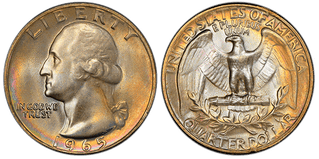
At first glance, the 1965 Washington quarter might look like any other coin rattling around in your pocket. But for numismatists and hobbyists, it represents a pivotal chapter in U.S. coinage history. To understand its true value today, we need to go back to why it exists in the first place—and what made it so different from its predecessors.
Before 1965, U.S. quarters were made of 90% silver and 10% copper. These silver quarters had both face value of 25 and intrinsic bullion value due to their metal content. But in the early 1960s, rising silver prices and hoarding behavior triggered a national coin shortage.
Then, how would you think, does a 1965 quarter have silver in it? Starting in 1965, quarters would no longer stay silver coins, instead being minted from a copper core clad in nickel.
This seemingly technical change had massive implications. Not only did it affect the quarter 1965 value in melt, but it also introduced new opportunities—and new 1965 quarter errors—that collectors would spend decades hunting down.
While billions of 1965 quarters were minted—over 1.8 billion to be precise—making them incredibly common in circulation, the transition year also resulted in a handful of anomalies and rare misprint 1965 quarter errors that collectors highly prize today. These include strikes on leftover silver planchets, off-center strikes, double dies, and more.
So, why pay attention to a 1965 no mint quarter?
- Historical Importance: It was the first year of clad coinage, ending the era of silver quarters. How much silver is in a 1965 quarter, if it is even here? If the coin is regular, there is none, but if you get your hands on a rare one, struck on the previous generation planchet, it will be 90% silver, making it valuable both in melt and for collectors.
- No Mint Marks: Due to the mint mark moratorium from 1965 to 1967, all 1965 quarters were struck at the Philadelphia Mint and lack a mint mark. That makes attribution harder but adds intrigue, as any 1965 quarter value no mint mark can be high.
- High-Grade and Error Variants: Despite the massive mintage, very few coins were preserved in pristine condition. And even fewer were minted with significant, valuable errors.
Quick Facts on 1965 Liberty Quarter
Whether you’re just starting your coin collection or have inherited a stash of old change, checking your 1965 quarter no mint mark value could be a low-effort, high-reward decision.
| Feature | Detail |
|---|---|
| Composition | Copper-nickel clad (no silver) |
| Weight | 5.67 grams (if not a silver error) |
| Diameter | 24.26 mm |
| Mint | Philadelphia (no mint mark) |
| Edge | Reeded (visible copper layers) |
| Mintage | ~1.8 billion |
While the base metal content of a standard 1965 quarter with no mint mark is minimal, some rare variants defy these characteristics. Knowing what to look for is key—and it can make the difference between 25 cents and thousands of dollars if it is a rare mistake or a 1965 silver quarter value.
Why Is There No Mint Mark on the 1965 Quarter?
If you’ve examined a coin wondering where is the mint mark on a 1965 quarter, don’t worry—this isn’t an error. In fact, there is no 1965 quarter mint mark location, regardless of where they were produced.
That’s because from 1965 to 1967, the U.S. Mint temporarily removed mint marks from all coins as part of a policy to discourage coin hoarding during the national coin shortage. The idea was to make coins less appealing to collectors so more would stay in circulation.
As a result, all 1965 quarters were struck at the Philadelphia Mint, and by design, they carry no identifying mint letter. This uniformity makes it harder to trace certain errors to a specific location but is historically accurate and completely normal for that year. The 1965 no mint mark quarter value differs strongly depending on the condition, possible mistakes, and dozens of other factors — we will explore them later.
How Much Is 1965 Quarter Worth? Quick Breakdown
Even though the vast majority of 1965 US quarter value only their face, certain examples break the mold. Their rarity, condition, and minting errors determine their sometimes astronomically high prices. Here’s how much is a 1965 silver quarter worth on auctions depending on the condition:
- Circulated: Typically worth $0.25 to $1 depending on condition.
- Uncirculated (MS60–MS65): Can sell for $1 to $15.
- High-Grade (MS67 or higher): May command $50–$500+.
- Rare Errors (e.g., silver planchet, double die): Sell for hundreds to tens of thousands of dollars.
We’ll explore these high-value variants and how to distinguish them from regular ones in the next section with more details, and here is a brief summary on Washington quarter values 1965-present.
| Condition | Estimated Value of a 1965 Quarter |
|---|---|
| Circulated | $0.25 – $1 |
| Uncirculated (MS60) | $1 – $15 |
| High Grade (MS67+) | $50 – $500+ |
| Silver Error Coin | $3,000 – $7,000+ |
Rare 1965 Quarter Varieties
While most 1965 quarters are common, circulating freely and often overlooked, a select few possess traits that elevate them from everyday currency to high-value collectibles. Whether it’s a subtle die misalignment or a dramatic strike on a silver planchet, these coins tell a story of minting anomalies and collector fascination. Let’s break down the most sought-after 1965 error quarter types that can fetch hundreds—or even thousands—of dollars on today’s market.
| Type | Error/Condition | Estimated Value |
|---|---|---|
| Silver Planchet Error | Wrong metal (90% silver) | $3,000 – $7,000+ |
| Double Die Obverse (DDO) | Doubling on letters & date (FS-101) | $40 – $1,200+ |
| Off-Center Strike | Part of design missing; date visible | $100 – $300 |
| Wrong Planchet Strike | Coin struck on a cent/dime planchet | $250 – $1,000+ |
| Multiple Strikes | Coin struck more than once | $400+ |
| Double Tail Eagle | Reverse design struck twice (extremely rare) | $30,000 – $80,000 |
1965 Quarter Error List with Pictures
Silver Planchet Error (The Holy Grail)
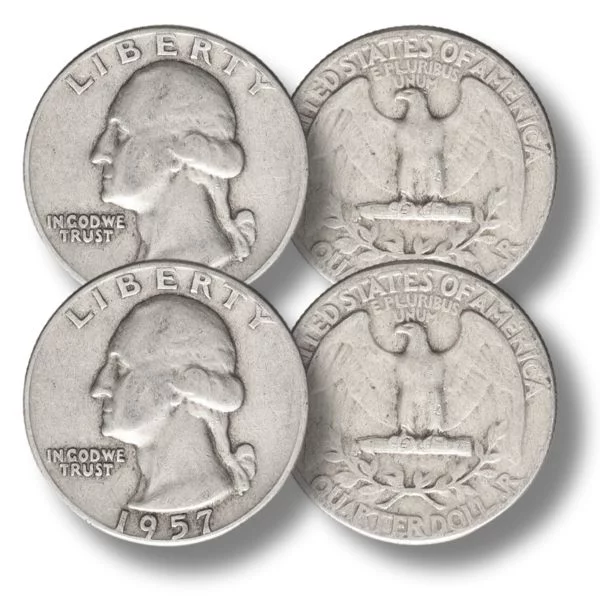
Despite the official transition to copper-nickel clad in 1965, a small batch of quarters were mistakenly struck on leftover 90% silver planchets from 1964. These coins are virtually indistinguishable at a glance but the 1965 quarter weight is slightly higher (6.25g vs. 5.67g), they also lack the visible copper edge.
How to Spot Is 1965 Quarter Silver:
- Weigh the coin precisely (silver ones are heavier)
- Check the coin’s edge—pure silver has a uniform shine, no copper strip
- Confirm with professional grading (PCGS, NGC)
Recent Sales:
- One certified silver error sold for $7,050 at auction.
Double Die Obverse (FS-101)
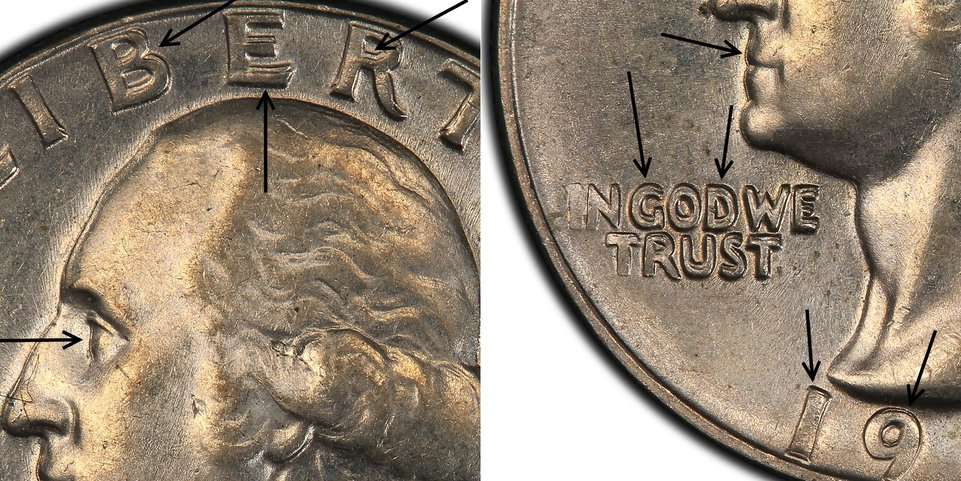
This striking error coin 1965 quarter appears during the hubbing process, causing inscriptions and design elements to appear doubled. The FS-101 variety displays doubling in “LIBERTY,” “IN GOD WE TRUST,” and the date “1965.”
Collectors Value It For:
- Visible design doubling without magnification
- Rarity across all coin grades
Potential Worth:
- $40 in lower grades
- Over $1,000 in MS65 or higher
Off-Center Strike
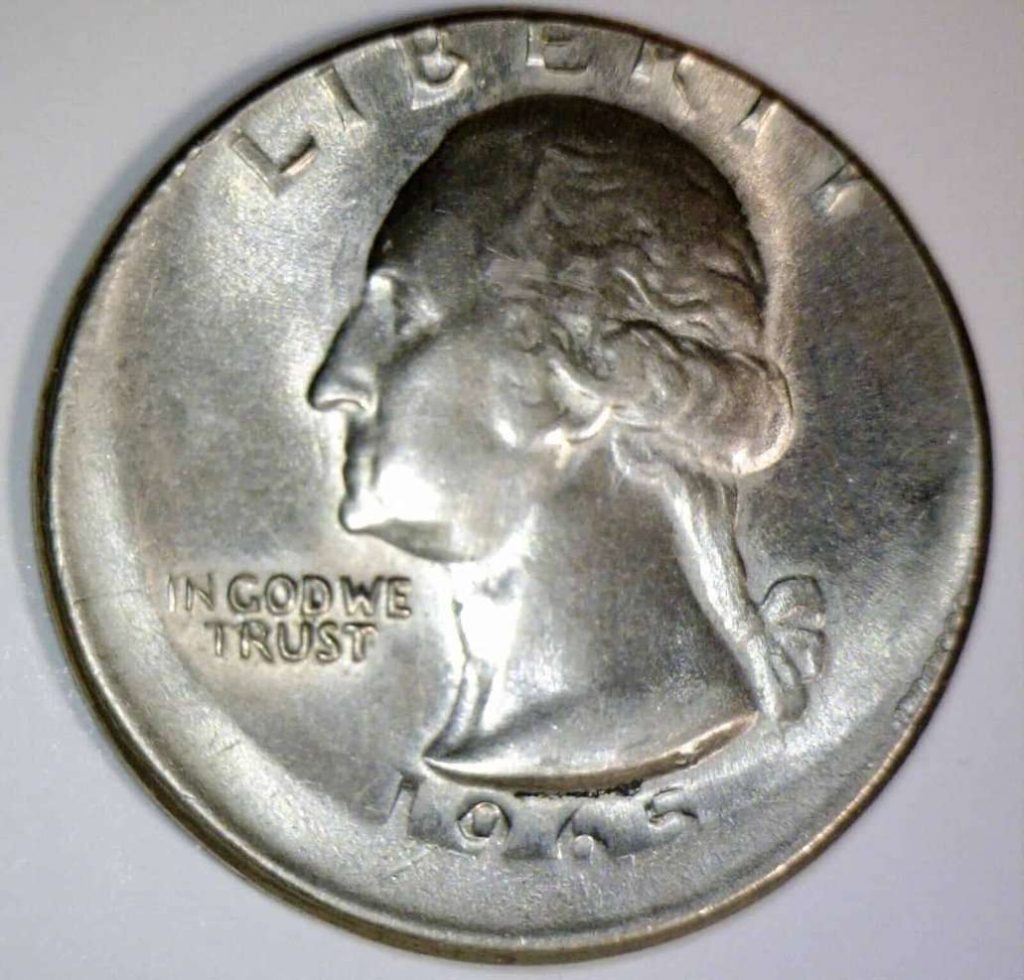
When a coin is misaligned during the strike, part of the design is missing, creating a unique shape and layout. The degree of the off-center strike and the visibility of the date significantly impact the value of 1965 quarter with such a mistake.
Pricing Guide:
- 10–30% off-center with visible date: $100–$300
- More dramatic or near 50% off-center: higher value, especially if it includes a full portrait
Wrong Planchet Errors
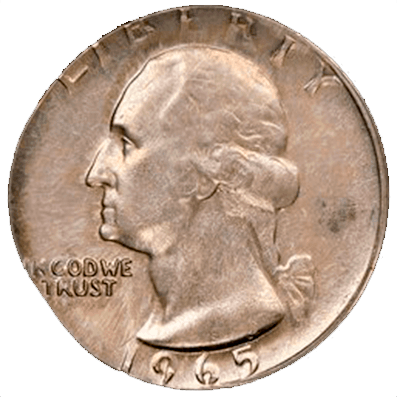
Some 1965 quarters were accidentally struck on planchets intended for other coins like cents or dimes. These errors create undersized or off-weight coins and are highly collectible.
Common Types:
- Struck on 3.11g copper penny planchet
- Struck on 2.27g dime planchet
Estimated Value:
- $250–$1,000 depending on condition and rarity
Multiple or Double Strikes
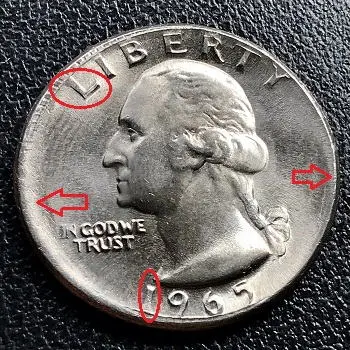
These coins were struck more than once during the minting process, resulting in overlapping designs, distorted features, or ghost-like images.
Collector Appeal:
- Highly visual error
- Clear proof of minting malfunction
Auction Values:
- Frequently sell for $400 or more, depending on strike clarity
Double Reverse (Double Tail Eagle)
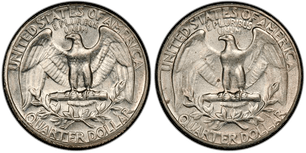
Probably the most legendary 1965 quarter value error in existence: the coin features two reverse (eagle) designs instead of an obverse and reverse. These are virtually unknown in circulation and are suspected to be test pieces or intentional mint blunders.
How Much Is a 1965 Quarter Worth in 2024 with such a mistake:
- Ranges from $30,000 to $80,000+ at auction
- Only a few confirmed examples exist
Die Rotation and Broad Strikes
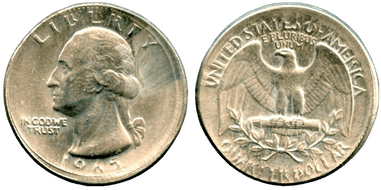
These lesser-known errors happen when the dies become misaligned or the collar fails during striking. A die rotation may cause the front and back designs to misalign, while a broad strike can expand the coin beyond its intended dimensions.
Typical Worth:
- $75 to $300 depending on severity and appeal
How to Spot a Treasure and Value 1965 Quarter Yourself? Simple Instruction
Spotting a no mint mark valuable 1965 quarter value isn’t always easy, especially when it comes to rare errors or high-grade examples. Here are some tips to quickly understand how much is a 1965 quarter worth with no mint mark.
Step 1: Check the Coin’s Weight
A typical clad 1965 quarter weighs 5.67 grams, while the rare 1965 quarter silver content planchet errors weigh around 6.25 grams. This small but measurable difference can be your first clue.
What You’ll Need:
- A digital coin scale (accurate to two decimal places)
How to Use It:
- Place the quarter on the scale and compare the weight.
- If it weighs 6.25g, you may have a rare and pricey error coin. Stop here and consider professional grading to check is a 1965 quarter silver.
Step 2: Examine the Edge
The edge of a 1965 clad quarter should show two layers: a copper core sandwiched between nickel. Another answer on ‘how to tell if a 1965 quarter is silver?’ is a uniform silver edge with no visible copper stripe.
Tip: Use a bright light and magnification to examine the edge carefully. Don’t confuse a dirty coin for a solid edge—look for color contrast, not just grime.
Step 3: Look for Key Errors and Doubled Dies
Keep trying to estimate how much is a quarter from 1965 worth? Now use a 10x magnifying loupe to spot relatively clearly seen mistakes:
| Area to Check | What to Look For |
|---|---|
| “LIBERTY” and “IN GOD WE TRUST” | Doubling on the letters (DDO) |
| The Date “1965” | Clear, split lines or doubling |
| Washington’s Portrait | Doubling along the neckline or jaw |
These indicators may suggest a Double Die Obverse (FS-101) error. Is a 1965 quarter worth anything with such a sign? Yes, and it can be worth hundreds to over $1,000 in high grades.
Step 4: Assess the Condition
Condition is everything in numismatics. A quarter that’s been through years of circulation with visible wear will always be worth less than one in pristine, uncirculated state.
Use the Sheldon Coin Grading Scale:
| Grade | Visual Description | Typical Value |
|---|---|---|
| G4 – VG10 | Heavy wear, date visible, major design worn | $0.25 – $0.50 |
| F12 – VF30 | Moderate wear, better details, rim intact | $0.50 – $1.00 |
| EF40 – AU58 | Minor wear on high points, luster still present | $1 – $5 |
| MS60 – MS65 | Uncirculated, light marks only visible under magnification | $5 – $50 |
| MS67+ | Almost perfect, no visible marks, brilliant strike | $100 – $500+ |
Use Technology: The Coin ID Scanner App
Gone are the days of flipping through coin books or scrolling forums for hours. Quickly check is 1965 quarter worth anything via the Coin ID Scanner app.
Features:
- Instant Coin Identification: Just snap a photo—get the type, year, and variety in seconds.
- Error Detection: AI scans for visible doubling, misalignments, or planchet oddities.
- Value Estimator: Uses real-time auction and grading data to show how much your coin is worth and see the previous data: for example, how much is a 1965 quarter worth in 2023 or 2024.
- Digital Coin Journal: Save photos and notes about your collection to track discoveries and updates.
Step-by-Step Instruction for Identifying a Valuable Quarter with a Coin ID Scanner
Follow these simple steps to scan your quarter and check if it’s a rare or valuable variety:
Step 1: Download and Install the App
Search “Coin ID Scanner” in the App Store (iOS) or Google Play Store (Android) and install the app. It’s lightweight and easy to set up.
Step 2: Open the App and Select “Scan Coin”
Tap on the “Scan Coin” button on the home screen.
Step 3: Take a Clear Photo
- Place your 1965 quarter on a flat, well-lit surface.
- Make sure the entire coin is visible.
- Use the app’s camera to take a clear photo of the obverse (front) and then the reverse (back).
Step 4: View Identification Results
The app will analyze your coin using its AI-powered recognition system and match it against a database of over 150,000 coin varieties. You’ll see:
- Coin type and year
- Composition (e.g., clad or silver)
- Estimated grade
- Possible error types detected (e.g., DDO, off-center strike)
Step 5: Check Estimated Value
Based on real auction data and market trends, the app provides a price estimate range depending on your coin’s condition and rarity.
Step 6: Save or Share Your Coin Data
You can save your coin to a personal digital collection, add notes, and even share it with other collectors or professional graders for second opinions.
Bonus Features
- Side-by-side comparison with known valuable 1965 quarters
- Smart alerts if your coin matches a known high-value error
- Collector tools like watchlists, grading tips, and market reports
Using Coin ID Scanner is one of the fastest and most reliable ways to turn a mystery quarter into a confidently evaluated collectible. If you’re serious about coin collecting—or just want to make sure you’re not overlooking a treasure—this app is a must-have in your digital toolkit.
Whether you’re new to the hobby or a seasoned pro, the Coin ID Scanner app can save time, improve accuracy, and even prevent you from accidentally spending a $5,000 coin at the grocery store.
Whether you’re a seasoned collector or just curious about the change in your pocket, understanding the potential value of a 1965 quarter can make coin collecting even more rewarding.